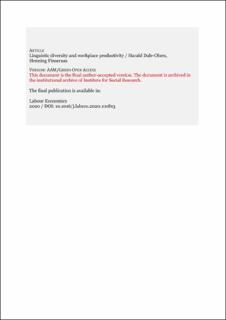| dc.contributor.author | Dale-Olsen, Harald | |
| dc.contributor.author | Finseraas, Henning | |
| dc.date.accessioned | 2021-11-23T08:05:59Z | |
| dc.date.available | 2021-11-23T08:05:59Z | |
| dc.date.created | 2020-05-20T11:18:56Z | |
| dc.date.issued | 2020 | |
| dc.identifier.citation | Labour Economics. 2020, . | |
| dc.identifier.issn | 0927-5371 | |
| dc.identifier.uri | https://hdl.handle.net/11250/2830864 | |
| dc.description.abstract | We study the importance of linguistic diversity in the workplace for workplace productivity. While cultural diversity might improve productivity through new ideas and innovation, linguistic diversity might increase communication costs and thereby reduce productivity. We apply a new measure of languages’ linguistic proximity to Norwegian linked employer-employee manufacturing data from 2003–12, and find that higher workforce linguistic diversity decreases productivity. We find a negative effect also when we control for the impact of cultural diversity. The detrimental impact disappears over time as immigrant workers’ expected proficiency in Norwegian improves since their time of arrival. | |
| dc.language.iso | eng | |
| dc.title | Linguistic diversity and workplace productivity | |
| dc.type | Peer reviewed | |
| dc.type | Journal article | |
| dc.description.version | publishedVersion | |
| dc.description.version | acceptedVersion | |
| dc.source.pagenumber | 16 | |
| dc.source.journal | Labour Economics | |
| dc.identifier.doi | 10.1016/j.labeco.2020.101813 | |
| dc.identifier.cristin | 1811875 | |
| dc.relation.project | Norges forskningsråd: 255595 | |
| cristin.ispublished | true | |
| cristin.fulltext | original | |
| cristin.fulltext | postprint | |
| cristin.qualitycode | 2 | |
